Project 8- Coco
During the summer leading up to my relocation to Cairo I was contacted by the producing organization El Adl about an epic project they were undertaking. An Egyptian mega-star named Sherihan, who had been a child star and had an incredibly prolific career in the 80’s and 90’s, was making her return to the stage after a 16 year break. That break was because she had suffered a broken back and then several years later was diagnosed with cancer, which led to part of her cheekbone removed. But as this return was cause for international celebration, they wanted to make the most of it. At the time I was contacted, the lighting designer who was originally contracted for the filming (that was supposed to have started in early summer) was leaving because of prior commitments. But since I wasn’t scheduled to arrive in Cairo until the end of August and shooting was supposed to have been started well before then, my services couldn’t be used. However, shooting was delayed even further and I received an email while I was flying to Egypt that they wanted to interview me once I was in country. On my second day in Cairo I traveled past the Pyramids to meet with the producing team. My experience working on the movie Center Stage and my live broadcasts of various theatrical events was exactly what they were looking for.
The original idea was to write, stage and film 13 brand new musicals, all about strong female characters to play to Sherihan’s personal strengths. The first one to be filmed was the story of the fashion designer Coco Chanel, aptly titled Coco. Filming was supposed to begin at the end of September and a new musical would be filmed every two weeks. I knew this sounded a little overly ambitious, but as I was in a new country and I remember what my father told me once, “While you’re in someone else’s house, never complain about the drapes.” It did strike me as funny that when I was contracted on August 24th, there wasn’t a director or cinematographer attached yet.
Through the next few weeks/months I made numerous trips from the eastern part of Cairo where I was living next to AUC, to the western part of the city (70km each direction). It was an intense learning curve for me on numerous levels. The lighting controller (an Avolites Arena) was something that I was unfamiliar with and its programming language was counterintuitive to what was needed for a theatrical event. We ended up hiring someone who knew the console better than anyone else in Egypt and he was one of the main reasons for my success on this project. Communication with the director (Hady Al Bagouri), choreographer (Hani Abaza), producers, star and director of photography (Ahmed El Moursi) was incredibly difficult because we were all speaking a different visual language. The set, script development and music composition were also very far behind. I did what I could and tried to create a design that would be good for the invited audiences on the days we filmed particular scenes as well as for the cameras. From the last film I worked on (in 1999) there had been some significant advances in camera technology. I had to relearn how lights looked through the camera eye. The schedule was chaotic and constantly changing. Regardless I was able to map out the basic scene structure, and was able to do some previsualization renderings to communicate to the director and director of photography (DP) how the lights could look. We also used the program to look at different camera angles.
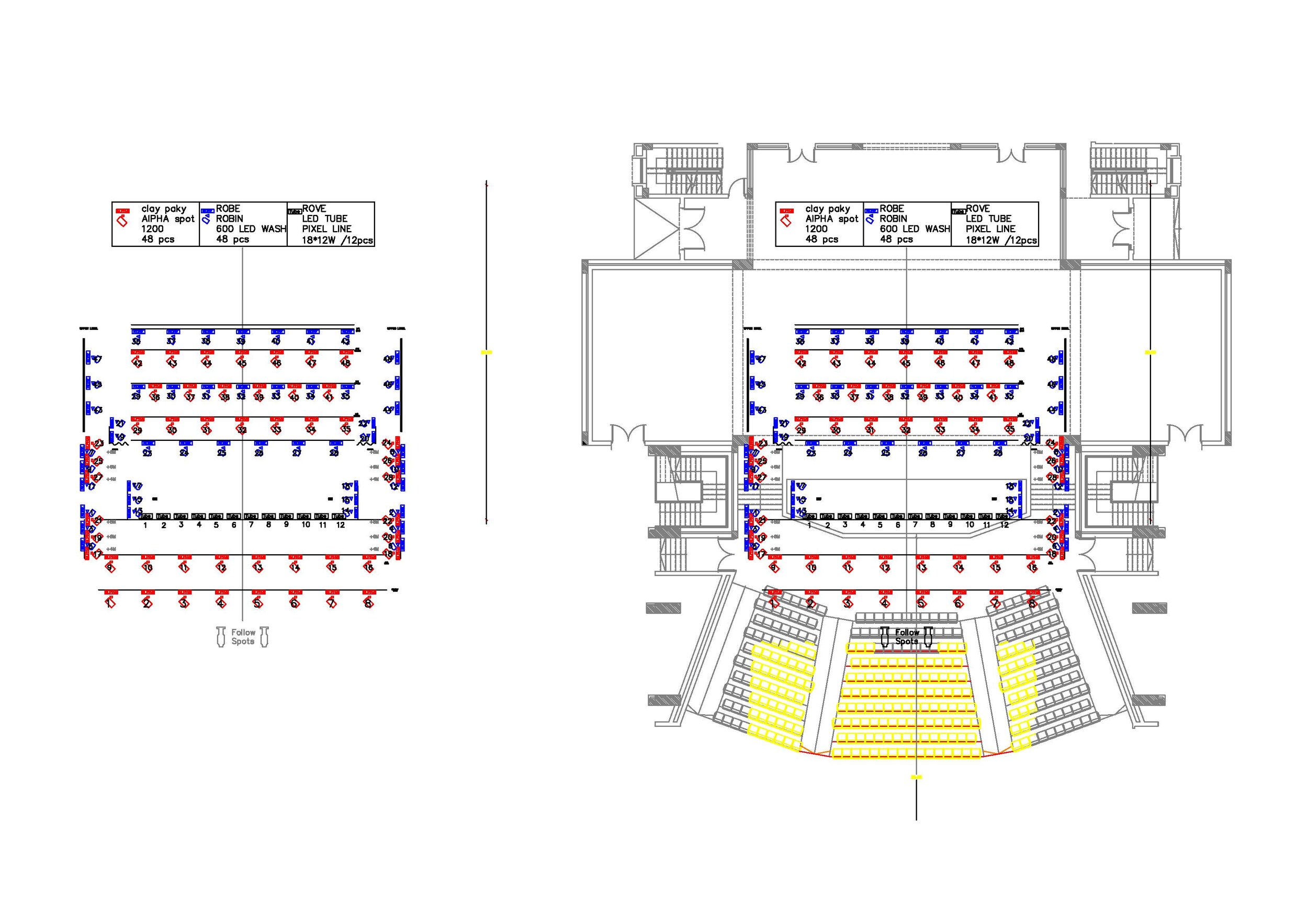

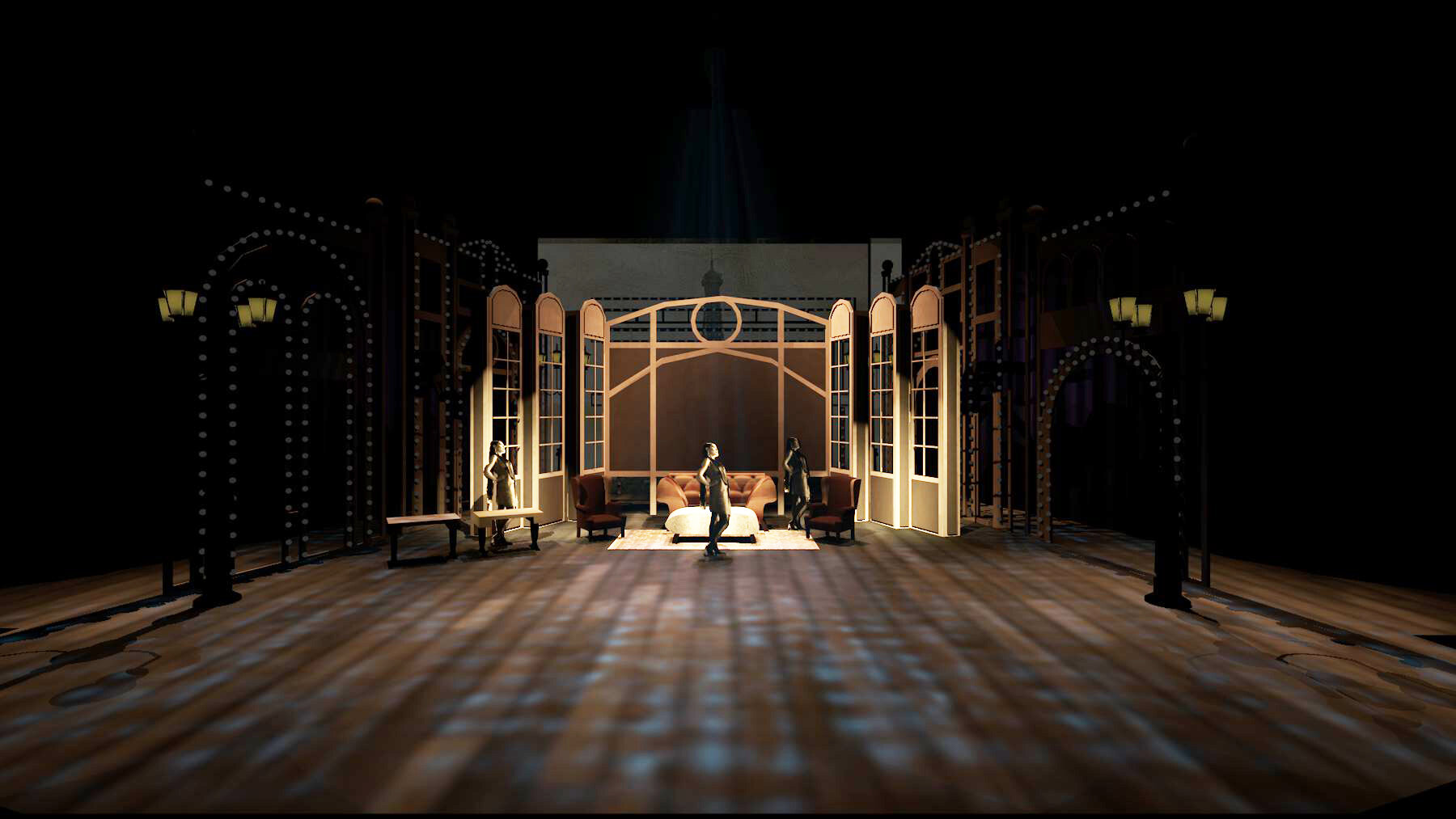


Finally, in mid-November we were ready to film the first scene. After an introductory scene of a grandmother explaining to her granddaughter who Coco Chanel was, the moment dissolved to the lights coming up on a Paris street of the early 1900’s. A camera followed from behind Sherihan as she made her entrance so the film audience sees her triumphant return to the stage from her point of view. Although it was a live audience, they did not typically see a continuous run of the scene and there were sometimes as many as seven cameras, booms and various staff (including myself) standing in their way. This first scene is the story of how Coco Chanel got her start in the fashion business and her unfortunate choices in love. The dramatic action weaves dialogue in and out of song and dance sections through a dynamic 15 minute long opening. This scene was filmed in repeated sections (seven in total) and shot with different camera set ups. The first option was always three cameras set up for long shots. Then, while that section was being reviewed by Sherihan, the director, the DP and myself, the cameras were moved and reconfigured for medium shots. That procedure was repeated for closeup shooting and then onstage shooting. For the onstage shooting of the seven minute dance section the follow spot that kept the star accentuated from the others in the cast was problematic. The shadows on her face were too harsh and there were occasional shadows cast by the steadicam operator. The solution was to have someone hold a softlight on a 2m pole to light her and would work in tandem with the steadicam operator. The issue was that the choreography was so complex they kept tripping on each other because neither person knew the dance. I was able to provide the solution. Because I knew the dance very well, they fitted me with a special harness that helped support the softlight and extension pole so I could hold in with one hand. I then followed the actress through the dance to always keep the light on her face while having the other hand free to put on the Steadicam operator’s right shoulder so I could move him (and his focus puller) where he needed to go. I used that and simple voice commands like “chamel …yalla” (left …go) to move us through the complex choreography so that we never interrupted the dance and got the shots we needed. We filmed that section of the dance without stopping three times in a row. It was apparent that I was not in the same shape I was 20 years ago. But my solution to the problem, along with my willingness to step in and help, began to establish my role as an equal collaborator with a highly respected set of Egyptian artists. We finished with a non-stop run of the first scene filmed live with seven cameras all shooting at the same time. Filming started at 2 in the afternoon and we finished at about 5am. I went home, changed clothes and then went to teach classes. While I can’t show the end product of this, here is a time-lapse showing some of the setup, lighting/camera check and the scene 1 set, with an interior that was flown in at the end of the dance as part of the transition to scene 2 that was filmed continuously. (https://www.youtube.com/watch?v=9sGCpq4IlQg).
Two weeks later we filmed the most complex scene of the story. It tells of how Coco, during the German occupation of France in the 1940’s, fell in love with a German officer. After the war she was ostracized from Paris. While there was no actual trial (to our knowledge) we created a theatrical telling of that exclusion from the world that she knew. The Egyptian term for this is “Damaroohah” (spelling may vary) and means to be cast out. As you will see in the video, the set was extensive. It’s centerpiece is a 10m wide see-saw that tips up and down and a dance was staged on it. The first section of the scene was a wide open stage with the large scenery pieces masked offstage and upstage by black curtains. At the end of the first dance section all of the dancers and star are downstage and the scenery is discreetly moved into place. The star is then carried upstage and put into a small cage at one end of the see-saw. The dance then tips the see-saw back and forth in front of a judge and two jury boxes. This scene was filmed in the same process we established the preceding week, and also presented some of the same problems. For the onstage close ups I again carried a softlight and was actually tied directly to the DP who stepped in to use a special handheld camera. During this time I was able to start offering input on both filming options and staging. But in order for the star and director to save face, I would discreetly mention the idea to the DP who would then tell the others. I later found out that he began using a special code phrase to indicate the idea came from me so that they would know, but not compromise their artistic leadership. Because of this and the visual appeal of my design, I found myself with a select few others leading the artistic process. The collaboration that the director, DP and I achieved during this filming session is nearly unparalleled in the rest of my entire career. Our work stands to this day as some of the finest I’ve ever done. The combination of our previsualization meetings to map out the lights and the cameras, along with our creative flexibility in the moment made for what some people have said is “the level that all Egyptian theater should try and be.” We finished filming as the sun was coming up again. On the way out dozens of people came up to me to congratulate me and my team. I tried to not let it go to my head and instead realized that in one 18 hour filming session I was able to establish myself and my career in my new country.
Coco- Damaroohah
The filming continued for the next six months. I made the 140km round trip over 100 times and never missed a class or AUC commitment. There were breaks because of scheduling conflicts, my postponed honeymoon and an injury to Sherihan’s back. Eventually in early May we concluded the filming. Part of the last day’s work was staging and filming the curtain call. I was honored to be invited to bow because of the quality of my work and contributions to the production. I was the only non-Arab invited to do so.
Below are select images and videos of some of the other scenes.
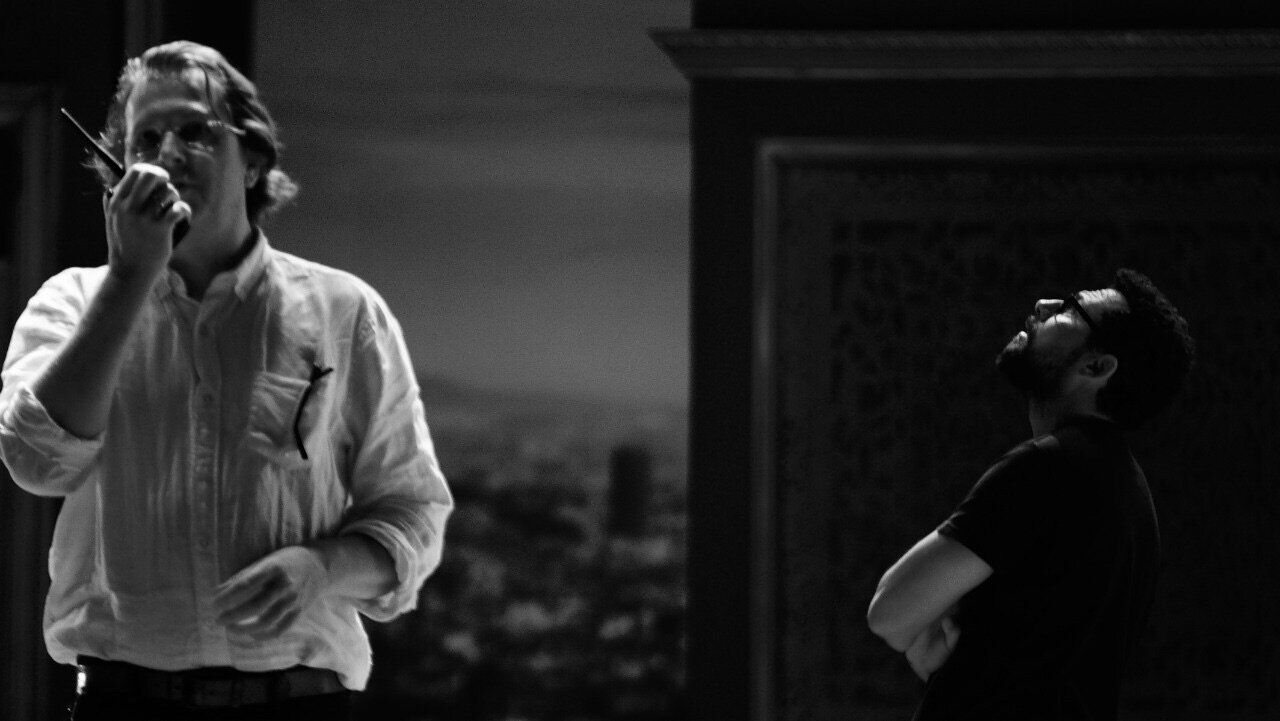
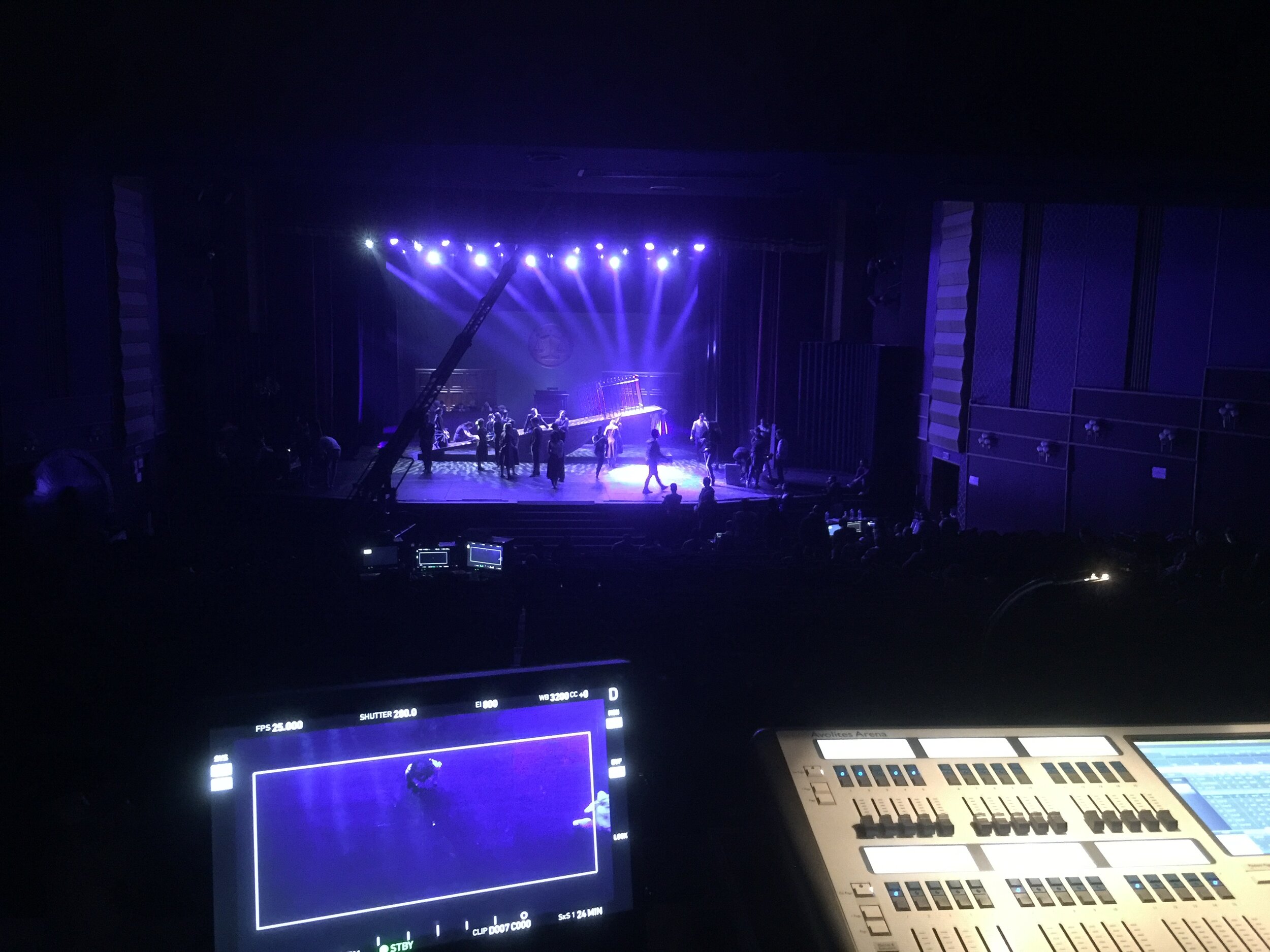
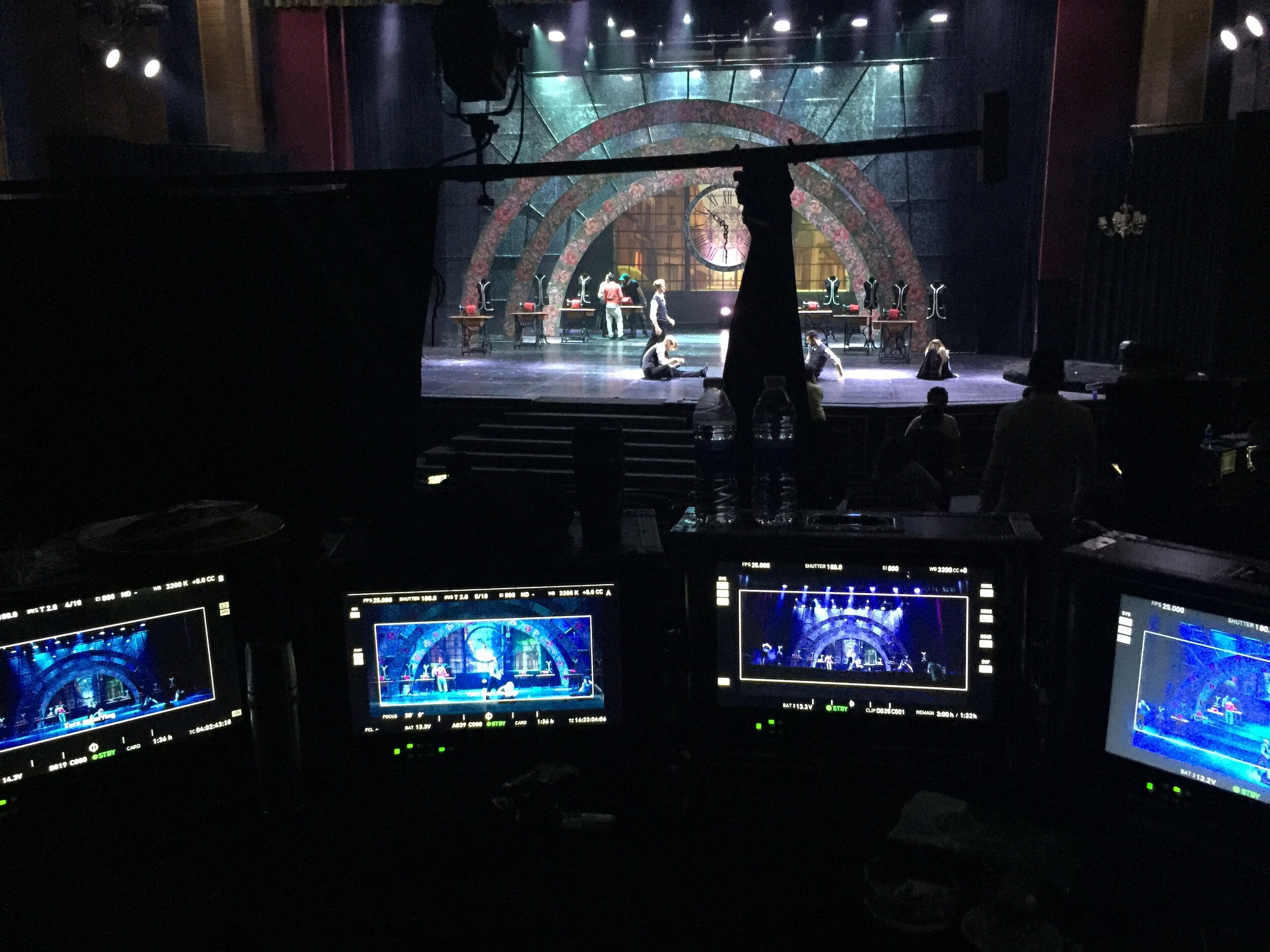
Coco- This is the moment the Nazi’s storm Paris (and the theater). I filmed this from my control area at the back of the audience. They can be seen through the cameras and over my left shoulder.
Coco- Time lapse of lighting and camera test for Coco’s exile scene. The video on the back wall of the small room was problematic until I provided my own projector, laptop and little bit of time to edit the video source to provide and elegant picture in a picture.
Time lapse of our setup for the final scene. Set in Coco’s sewing shop she comes to a theatrical end and flies magically to the heavens, trailing 5m of gossamer fabric from her dress.
Coco- Camera test for the final scene. (through the camera’s eye)
After nearly two years the negotiations for distribution are still in process. But the initial estimates, based on early ad sales, indicates that there will be between 100 and 200 million people who will view this filmed theatrical event in Egypt and throughout northern Africa and the Middle East.

